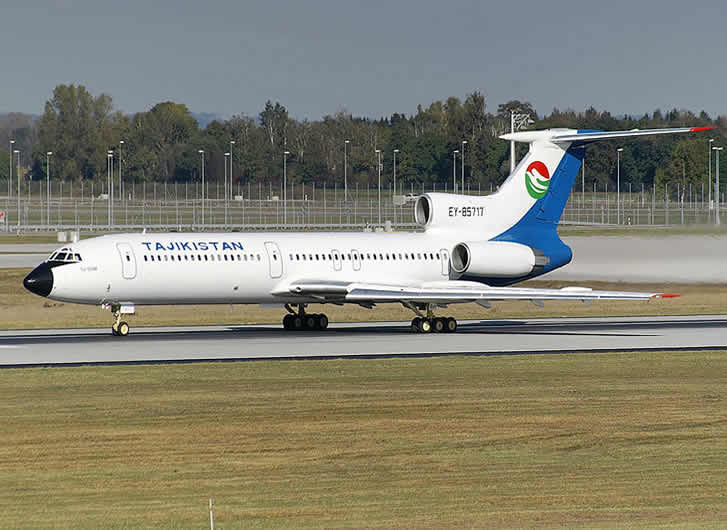The Tupolev Tu-154 (Russian: Туполев Ту-154) is a Soviet medium-range trijet airliner, similar to the Boeing 727 and of particularly rugged design.
It remains the standard airliner for domestic routes in Russia and other states of the former Soviet Union and to a lesser extent in eastern Europe and Iran. The mainstay of Russian airlines for several decades, the Tu-154 has carried about half of all passengers flown by Aeroflot and its subsidiaries, or approximately 137 million passengers per year, and has been exported and operated by at least 17 foreign airlines. Designed to cope with unpaved and gravel airfields, the plane often operates in extreme Arctic conditions and although production has ceased, there have been requests for resumption of assembly. The Tu-154 often approaches Mach 1 speed making it one of the fastest commercial jets in operation.

The Tu-154 was developed to meet the Aeroflot requirement for a new aircraft to replace the jet-powered Tu-104, plus the Antonov An-10 'Ukraine' and Ilyushin Il-18 turboprops. It competed against the Ilyushin Il-62. The Soviet Ministry of Aircraft Industry picked the Tu-154 because it incorporated the latest in Soviet aircraft design and best met Aeroflot's anticipated requirements of the 1970s and 1980s. The aircraft was to transport a payload of 16 to 18 tons (35,270 to 39,680 lb) over a distance of 2,850 - 4,000 km (1,770 - 2,480 mi) while cruising at a speed of 900 km/h, or a payload of 5.8 tons (12,790 lb) over a distance of 5,800 - 7,000 km (3,600 - 4,350 mi) while cruising at 850 km/h (528 mph). It also had to be able to operate from airfields as short as 2,600 m (8,530 ft) at maximum take-off weight.
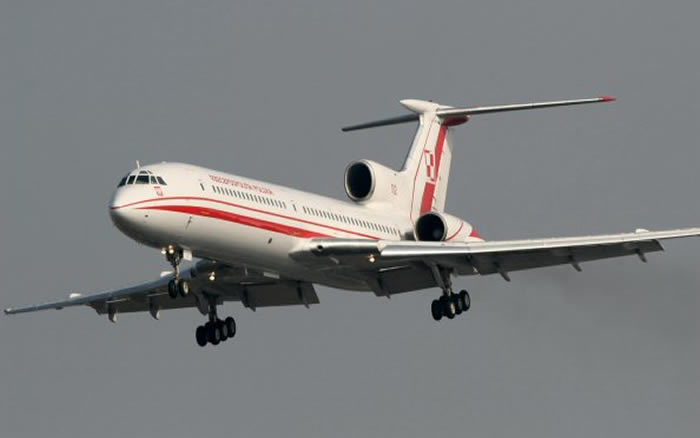
The first project chief was Sergey M. Yerger. In 1964 Dimitriy S. Markov assumed that position. In 1975 he turned it over to Aleksandr S. Shengardt.
Major design features
3 engines
powerful high lift devices such as leading edge slats, triple-slotted flaps, and spoilers
for the first time in Soviet aircraft design, a high level of reserve was built into all systems, thereby increasing its safety
for the first time on any Soviet airliner, irreversible hydraulic actuators on all three control channels
six wheel main landing gear, which assisted with braking and deceleration
for the first time in the Tupolev Design Bureau's history, there was an auxiliary power unit for engine starting and to supply power to the aircraft while on the ground
another first for the Tupolev Design Bureau was a primary electric system that used stable frequency AC power, with two generators connected in parallel for greater reliability.
reverse thrusters that can safely be deployed in-flight.
an automated flight control system that allowed automated piloting under all conditions, including automated landing.
The Tu-154 first flew on October 4, 1968. Commercial service began in February 1972, and production ended in 2006.
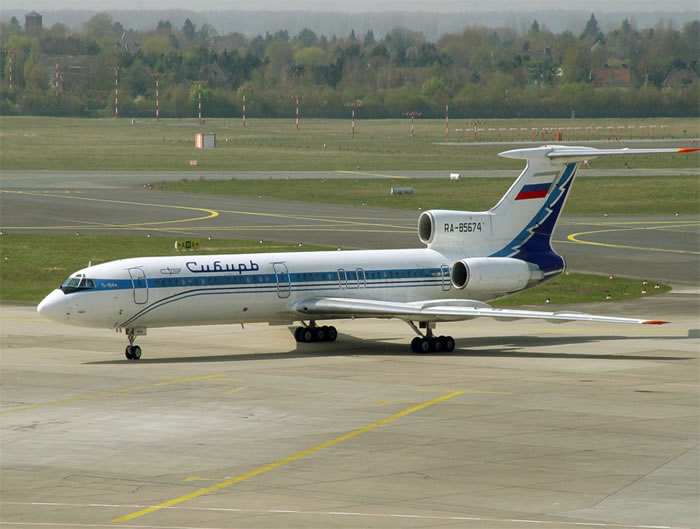
In 1988 a modified Tu-154 (dubbed Tu-155 and Tu-156) successfully flew on liquid hydrogen and in 1989 on liquified natural gas used as a fuel in its engines.
Design features
Aeroflot Tu-154 at Moscow Sheremetyevo AirportThe Tu-154 is powered by three rear-mounted low-bypass turbofan engines arranged similarly to those of the Boeing 727, and is slightly larger than its American counterpart. The original model had Kuznetsov NK-8-2, while the Tu-154M has Soloviev D-30KU-154s. All Tu-154 aircraft models have a higher thrust-to-weight ratio than that of the 727 – this gives them superior performance, although at the expense of poorer fuel efficiency, which became an important factor in later decades as fuel costs grew.
The cabin of the Tu-154, although of the same six-abreast seating layout, gives the impression of an oval interior, with a lower ceiling than is common on western airliners (Boeing or Airbus). The passenger doors are also smaller than on the Tu-154's western counterparts. Furthermore, luggage space in the overhead compartments is very limited.

Like the Tupolev Tu-134, the Tu-154 has a wing swept back at 35 degrees at the quarter-chord line. The British Hawker Siddeley Trident has the same sweepback angle, while the Boeing 727 has a slightly smaller sweepback angle of 32 degrees.
Like many other Soviet-built airliners, the Tu-154 has an oversized landing gear enabling it to land on unpaved runways, once common in rural areas of the Soviet Union. The aircraft has two six-wheel main bogies fitted with large low-pressure tyres which retract into pods extending from the trailing edges of the wings (a common Tupolev feature), plus a two-wheel nose gear unit. Soft oleo struts (shock absorbers) provide much smoother ride on the bumpy airfields than Western airliners, which only very rarely operate on such poor surfaces.
The passenger cabin accommodates 128 passengers in two-class layout and 164 passengers in single-class layout, and up to 180 passengers in high-density layout. The layout can be modified to what is called a winterized version where some seats are taken out and a wardrobe is installed for passenger coats.
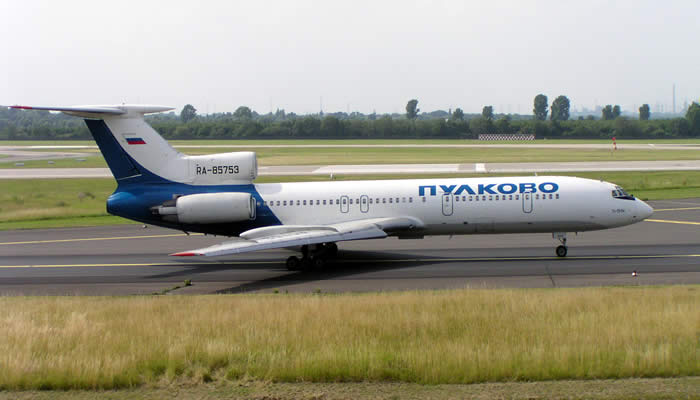
Although the original requirement was to have a 3 man flight crew (as opposed to 4 or 5 man crew on other Soviet airliners), and the plane actually can be flown with a crew of 3 - the Captain, First Officer and Flight Engineer, the fourth crew member - the Navigator - is usually present, at least in the former Soviet Union, due to the union rules. Navigators are no longer trained and this profession will become obsolete with the retirement of older Soviet planes.
The plane's avionics suite, for the first time in the Soviet Union, is built to Western airworthiness standards and includes an NVU-B3 doppler navigation system, a triple autopilot, which provides an automatic ILS approach according to ICAO category II weather minima, an autothrottle, a Doppler drift and speed measure system (DISS), "Kurs-MP" radio navigation suite and others. Modern upgrades normally include a TCAS, GPS and other modern systems, mostly Western-made.
Aeroflot Tupolev Tu-154 at Zvartnots International AirportThe earlier versions of Tu-154 cannot be modified to meet the current Stage III noise regulations, and therefore are banned to fly in Europe and other regions, where such regulations are in force. The Tu-154M, however, can be hushkitted to meet the Stage III regulations. Theoretically, it can be hushkitted to meet the formal Stage IV noise regulations. However, as the current European Union directives prohibit to hush kit aircraft to meet Stage IV noise levels, unless the TU-154M is re-engined, which will require extensive modifications that can be astronomically expensive, so it is unlikely that Tu-154 may continue operating in the EU with Stage IV regulations in force.
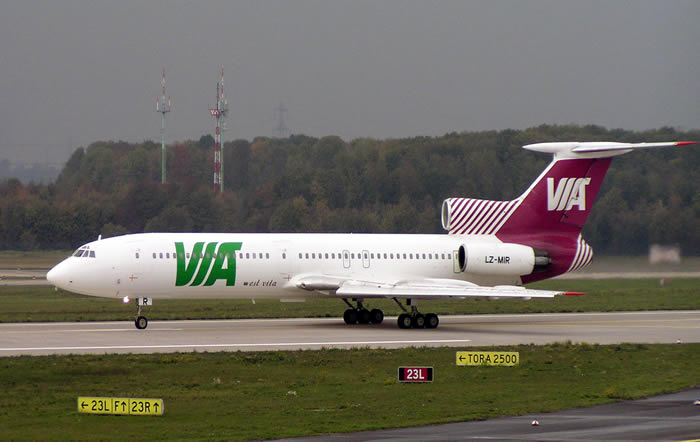
About 900 of Tu-154s have been built, 500 of which are still in service.
Variants
Aeroflot Tupolev Tu-154
Bulgarian VIA Tupolev Tu-154M at Düsseldorf Airport, 2003Many variants of this airliner have been built. Apart from the normal differences between weights and powerplants, the Tu-154 was produced in variants which used exotic fuels. Like its western counterpart, the 727, many of the Tu-154s in service have been hush-kitted, and some converted to freighters.
Tu-154
Tu-154 production started in 1970, while first passenger flight was performed at February 9, 1972. Powered by Kuznetsov NK-8-2 turbofans, it carried 164 passengers. About 42 were built. Tail numbers from 85006 to 85055.
Tu-154A
The first upgraded version of the original Tu-154, the A model, in production since 1974, added centre-section fuel tanks and more emergency exits, while engines were upgraded to higher-thrust Kuznetsov NK-8-2U. Other upgrades include automatic flaps/slats and stabilizer controls and modified avionics. Max. take-off weight - 94,000 kg. There were 15 different interior layouts for the different domestic and international customers of the airplane, seating between 144 and 152 passengers. The easiest way to tell the A model from the base model is the spike at the junction of the fin and tail is a fat bullet on the A model rather than a slender spike on the base model. Tail numbers from 85056 to 85119.
Tu-154B
As the original Tu-154 and Tu-154A suffered wing cracks after only a few years in service, a version with a new, stronger wing, designated Tu-154B, went into production in 1975. It also had an extra fuel tank in fuselage, extra emergency exits in the tail, and the maximum take-off weight grew to 98 tonnes. Also important to Aeroflot was that the increased passenger capacity led to lower operating costs. As long as the airplane had the NK-8-2U engines the only way to improve the economics of the airplane was to spread costs across more seats. The autopilot was certified for ICAO Category II automatic approaches. Most previously built Tu-154 and Tu-154A were also modified into this variant, with the replacement of the wing. Max. take-off weight increased to 96,000 kg. 111 were built. Tail numbers ran from 85120 to 85225.
Tu-154B-1
Aeroflot wanted this version for increased revenue on domestic routes. It carried 160 passengers. This version also had some minor modifications to fuel system, avionics, air conditioning, landing gear. 64 were built from 1977-1978. Tail numbers from 85226 to 85294.
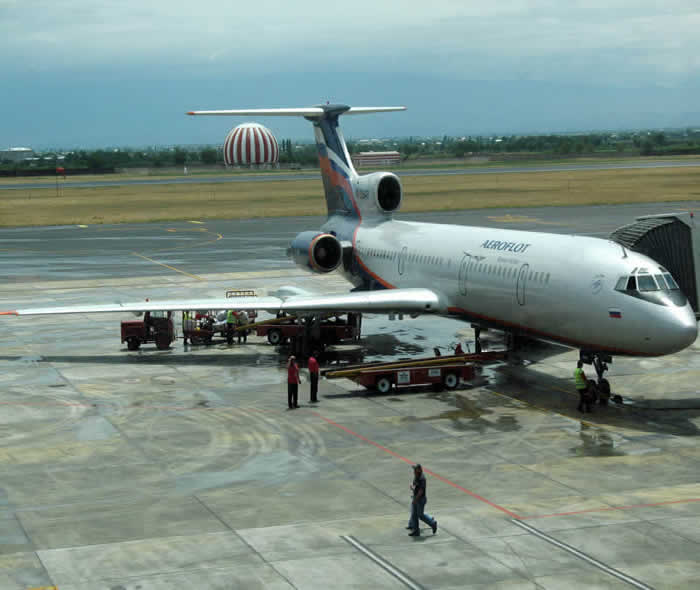
Air Koryo Tu-154B-2 at Samjiyeon AirportTu-154B-2
A minor modernization of Tu-154B-1. The airplane was designed to be converted from the 160 passener version to a 180 passenger version by removing the galley. The procedure took about two and a half hours. Some of the earlier Tu-154B modified to that standard. Max. take-off weight increased to 98,000 kg, later to 100,000 kg. 311 aircraft were built, including VIP versions. Tail numbers (new-built) from 85295 to 85605.
Tu-154S
The Tu-154S is an all-cargo or freighter version of the Tu-154B, using a strengthened floor, and adding a forward cargo door on the port side of the fuselage. The airplane could carry 9 Soviet PAV-3 pallets. Max. payload - 20,000 kg. There were plans for 20 aircraft, but only nine aircraft were converted; two from Tu-154 model and seven from Tu-154B model. Trials were held in the early 1980's and the aircraft was authorized regular operations in 1984. By 1997 all had been retired. Tail numbers: 85019 (Tu-154), 85037 (Tu-154), 85060, 85062, 85063, 85067, 85081, 85084, 85086.
Kavminvodyavia Tupolev Tu-154 at Mineralnye Vody AirportTu-154M
The Tu-154M is the deeply upgraded version, which first flew in 1982 and entered mass production in 1984. It uses more fuel-efficient Soloviev D-30KU-154 turbofans. Together with significant aerodynamic refinement, this led to much lower fuel consumption and therefore longer range, as well as lower operating costs. The aircraft has new double-slotted (instead of tripple-slotted) flaps, with an extra 36-degree position (in addition to existing 15, 28 and 45-degree positions on older versions), which allows reduction of noise on approach. It also has a relocated auxiliary power unit and numerous other improvements. Manufacture continued through 2006. Max. take-off weight increased first to 100,000 kg, then to 102,000 kg. Some aircraft are certified to 104,000 kg. Tail numbers are 85616 (prototype), production aircraft from 85606 and on (except 85804, which is re-imported Tu-154B-2). About 320 were manufactured. Production ended in 2006. No new airframes have been built since the early 1990s, and production since then has involved assembling airplanes from components on hand.
Tu-154M-LK-1
Cosmonaut Trainer. This was a Salon VIP aircraft modified to train cosmonauts to fly the Buran reusable spacecraft, the Soviet equivalent of the US Space Shuttle. The Tu-154 was used because the Buran required a steep descent, and the Tu-154 was capable of replicating that. The cabin featured trainee work-stations, one of which was the same as the Buran's flightdeck. The forward baggage compartment was converted into a camera bay, because the aircraft was also used to train cosmonauts in observation and photographic techniques.
Tu-154M-ON Monitoring Aircraft
Germany modified one of the Tu-154's it had on hand from the former East German Air Force into an observation airplane. This airplane was involved with the Open Skies inspection flights. It was converted at the Elbe Aircraft Plant (Elbe Flugzeugwerke) at Dresden-Klotzsche, and flew in 1996. After two dozen monitoring missions, it was lost in a mid-air collision in 1997.
The Russians also converted a Tu-154M to serve as an Open Skies Monitoring aircraft. They used the Tu-154M-LK-1, and converted it to a Tu-154M-ON. When the aircraft is not flying over North America, it is used to ferry cosmonauts around. The Chinese are also believed to have converted one Tu-154 to an electronic countermeasures aircraft.
Tu-154M-100
Design of this variant started in 1994, but the first aircraft were not delivered until 1998. It is an upgraded version with western avionics, including the Flight Management Computer, GPS, EGPWS, TCAS, and other modern systems. The airplane could carry up to 157 passengers. The cabin featured an automatic oxygen system and larger overhead bins. Only three were produced, as payment of debts owed by Russia to Slovakia. Three aircraft were delivered in 1998 to Slovak Airlines, and sold back to Russia in 2003.
Tu-155/Tu-156
Two prototypes based on this aircraft are the hydrogen- or natural gas-powered Tu-155 and Tu-156. The Tu-155 used first hydrogen,(reg. number CCCP-85035) then later liqued natural gas (LNG), as fuel for its starboard engine. Its maiden flight was on April 15th, 1988. It flew until 1992 and was placed in storage. It used the Kuznetsov NK-86 engines. The Tu-156 never made it past the mock-up stage. All three engines were to burn either hydrogen or natural gas. Cryogenics technology is used to store the liquid fuel in the Tu-155 and Tu-156.
|
